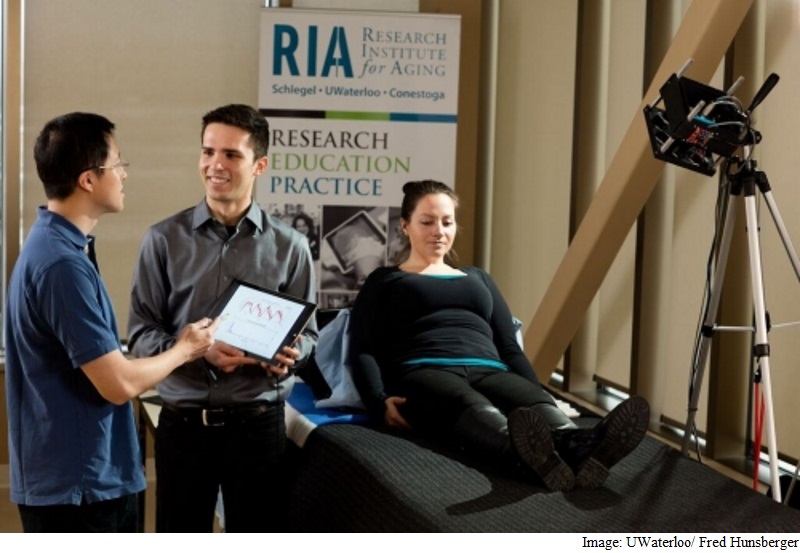- Home
- Science
- Science News
- New Touchless Device to Better Detect Heart Problems
New Touchless Device to Better Detect Heart Problems

Using patent-pending technology called Coded Hemodynamic Imaging, the device developed by researchers at the University of Waterloo monitors a patient's blood flow at multiple arterial points simultaneously and without direct contact with the skin, a university statement said.
It is ideal for assessing patients with painful burns, highly contagious diseases, or infants in neonatal intensive care whose tiny fingers make traditional monitoring difficult.
"Traditional systems in wide use now take one blood-pulse reading at one spot on the body. This device acts like many virtual sensors that measure blood-flow behaviour on various parts of the body. The device relays measurements from all of these pulse points to a computer for continuous monitoring," said Robert Amelard, a systems design engineer at Waterloo.
"By way of comparison, think of measuring the traffic flow across an entire city rather than through one intersection," said Amelard, who is a recipient of the prestigious Alexander Graham Bell Canada Graduate Scholarship from the Natural Sciences and Engineering Research Council of Canada.
Continuous data collection at different parts of the body provides a more complete picture of what's happening in the body.
Whole-body imaging opens doors for advanced monitoring that can't be done with the traditional, single-point methods.
"Since the device can also scan multiple patients individually at once and from a distance, consider the potential in mass emergency scenarios or long-term care homes," said professor Alexander Wong of the Faculty of Engineering at Waterloo and Canada Research Chair in Medical Imaging Systems.
"This technology provides for a more predictive approach to monitor vitals and the potential for its use is extensive, such as indicating arterial blockages that might otherwise go undetected, or warning older adults who risk falling as a result of getting dizzy when they stand," Wong said.
Get your daily dose of tech news, reviews, and insights, in under 80 characters on Gadgets 360 Turbo. Connect with fellow tech lovers on our Forum. Follow us on X, Facebook, WhatsApp, Threads and Google News for instant updates. Catch all the action on our YouTube channel.
- Samsung Galaxy Unpacked 2025
- ChatGPT
- Redmi Note 14 Pro+
- iPhone 16
- Apple Vision Pro
- Oneplus 12
- OnePlus Nord CE 3 Lite 5G
- iPhone 13
- Xiaomi 14 Pro
- Oppo Find N3
- Tecno Spark Go (2023)
- Realme V30
- Best Phones Under 25000
- Samsung Galaxy S24 Series
- Cryptocurrency
- iQoo 12
- Samsung Galaxy S24 Ultra
- Giottus
- Samsung Galaxy Z Flip 5
- Apple 'Scary Fast'
- Housefull 5
- GoPro Hero 12 Black Review
- Invincible Season 2
- JioGlass
- HD Ready TV
- Laptop Under 50000
- Smartwatch Under 10000
- Latest Mobile Phones
- Compare Phones
- Redmi Note 15 5G
- Redmi Note 15 Pro 5G
- Redmi Note 15 Pro+ 5G
- Lava Play Max
- Poco C85 5G
- Honor Magic 8 Lite
- Jolla Phone
- Realme P4x 5G
- Asus ProArt P16
- MacBook Pro 14-inch (M5, 2025)
- OnePlus Pad Go 2
- Poco Pad M1
- Just Corseca Skywatch Pro
- Honor Watch X5
- Acerpure Nitro Z Series 100-inch QLED TV
- Samsung 43 Inch LED Ultra HD (4K) Smart TV (UA43UE81AFULXL)
- Asus ROG Ally
- Nintendo Switch Lite
- Haier 1.6 Ton 5 Star Inverter Split AC (HSU19G-MZAID5BN-INV)
- Haier 1.6 Ton 5 Star Inverter Split AC (HSU19G-MZAIM5BN-INV)












